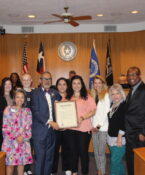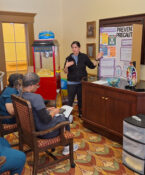What you should know about the COVID vaccine rollout
Almost one year into the COVID-19 pandemic, the world stands poised and hopeful for a safe return to everyday life. New vaccines are rolling out across the country to speed solutions to communities in Texas and other states, reaching front-line healthcare workers, residents of long-term care facilities and other priority groups first.
Over 300,000 Americans have died from complications of coronavirus and millions more have been impacted. The World Health Organization (WHO) estimates that approximately 60-70% of the population rolling up their sleeves could help achieve the needed levels for herd immunity to stop the spread of this disease.
“The Pfizer vaccine now being administered across the U.S. has been shown in clinical trials to be more than 94% effective at stopping or slowing coronavirus,” said HSC epidemiologist Erika Thompson, PhD. Dr. Thompson is a faculty member in the HSC School of Public Health with a background in vaccines research and advocacy.
The key to fighting COVID will be widespread vaccine adoption over the coming months, as well as continuing to wear masks and practice safe social distancing.
“Keep the mask and continue to physically distance for now,” Dr. Thompson said, “It could take a while as vaccines are delivered and administered in phased rollouts across each state. Most people will probably have to wait months for vaccinations to become widely available to the public, as those with the most urgent risk factors are being prioritized first. We’ve already seen the first doses shipped to Fort Worth area hospitals for administration, which is great news.”
The Pfizer and Moderna COVID vaccines each require two doses at timed intervals weeks apart. What’s still to be determined is the level of effectiveness at each step along the way. For some people, that may mean symptoms are reduced if they do get sick, but they might still be contagious to others. It might mean annual boosters could be needed. Public health experts caution that the coronavirus may never entirely be stamped out and might become one of the many seasonal viruses we prepare for each year.
Are there side effects?
Vaccine manufacturers have advised that possible, mild side effects could include muscle aches, fatigue, fever, chills and headache. There’s a chance that other side effects may turn up over time as more people are vaccinated.
“Any vaccine may have side effects,” Dr. Thompson said, “But the most important consideration is that the lifesaving prevention generally far outweighs the risks for the individual and the broader community.”
Research has shown that people tend to fall into one of three categories when it comes to vaccinations: those who receive all recommended vaccines, those who never will and those who approach vaccines with some hesitancy. Some people may forego vaccinations that aren’t required, thinking they may not be as important, while others may fear getting sick with the very disease vaccines are designed to prevent.
For those who fear catching the flu from an annual flu shot, as an example, that’s just not the case, Dr. Thompson said.
“The timing is more likely coincidental – maybe you’ve been exposed to a cold or the flu around the same time as receiving your immunization, but you’re not going to get the flu from the flu shot,” she said. “Public confidence in the COVID vaccine program will be important if we really want to beat this disease. We need to make COVID vaccination the norm. I’m personally looking forward to getting the vaccine when the time comes.”
Reaching those most impacted by COVID
Populations of color have been disproportionately affected by COVID-19, yet the African American, Latino and Native American communities who most need the vaccine may be hesitant to get it. Past harm done to Black communities by medical research injustices in historical cases like the Tuskegee Study of decades ago have created layers of distrust that may be hard to break through. Today, systems are in place to protect people, from Institutional Review Board (IRB) regulations on research to the FDA protocols required before any vaccine ever reaches the market.
HSC is involved in efforts across Texas to reassure these communities that the COVID vaccines are safe and effective, and to encourage their participation, through a National Institutes of Health (NIH) program called Community Engagement Alliance (CEAL) Against COVID-19 Disparities. The Texas CEAL Consortium is led by Dr. Jamboor K. Vishwanatha, Regents Professor and Founding Director for the HSC Texas Center for Health Disparities.
Researchers across HSC like Dr. Thompson are involved in the project, including Dr. Erica Spears, Dr. Teresa Wagner, Dr. Usha Sambamoorthi and Dr. Emily Spence, who are focusing on populations in 12 Tarrant County zip codes of highest priority. Using a community-based participatory research approach, various organizations and community leaders have partnered with HSC in this effort. The United Way of Tarrant County, DFW Community Health Worker Association, Tarrant County Public Health and the YMCA of Metropolitan Fort Worth are working with HSC faculty to design and implement the Tarrant County CEAL projects.
The outlook for 2021
“A lot of the work being done now involves building public confidence in the vaccines,” Dr. Thompson said. “To help everyone across the state and the U.S. get answers to their questions, to dispel myths and any misinformation being shared, and to help people feel comfortable and ready as each state follows its distribution plan for a phased rollout over the coming months.”
“This is quite an undertaking, and it’s not going to happen overnight, so it will involve some patience from all of us, and an acknowledgement that what we know now may change as more vaccines are administered to more people and we monitor results. This is how science works and how breakthroughs are accomplished, as we respond, learn, adjust and beat the virus together,” she said.




![Uyen Sa Nguyen Scaled[58]](https://www.unthsc.edu/newsroom/wp-content/uploads/sites/16/Uyen-Sa-Nguyen-scaled58-145x175.jpg)

Social media